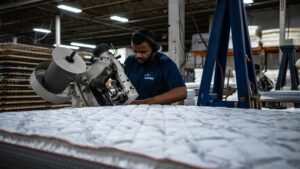
How a Mattress is Made
13th May 2022Ever wondered how your mattress is constructed? There is more to a mattress than you think and it all starts with the manufacturing process.
There are basically three types of mattresses on the market these days, latex, memory foam and inner spring mattresses.
Coils
The centre of a mattress has an innerspring unit, this is normal for all mattresses. Inner springs consists of numerous wire coils that are either individually wrapped or wrapped as a group.
Once all the wires are securely connected, the layers of upholstery are attached. The insulating layer is the first layer of upholstery and its purpose is to stop the delicate, comfortable cushioning from coming into contact with the wire spring and damaging it.
Insulating layers are industry standard size and has nothing to do with the comfort of the mattress or the support that the mattress is going to give.
Changes from mattress to mattress are the cushioning layers, those are the layers that will be providing comfort. Completing this section of a mattress, flanges are attached to the mattress cover.
Flanges are panels that connect the inner springs to the cover making sure that none of the internal parts of the mattress are left hanging loosely.
Don’t ever judge the quality of a mattress by how many springs it contains, a mattress with a high innerspring count doesn’t automatically mean that the mattress is going to be of a superior quality.
There is so much more than just the spring that determines the quality of a mattress.
Innerspring System
There are four different types of innerspring systems, Bonnell, Offset, Continuous and Pocket spring System.
Bonnell
Bonnell coil systems consist of coils that are knotted at both ends and are hour glass in shape. The Bonnell System of coils is popular and used in a variety of mattresses.
Offset
The Offset coil system is also shaped like an hour glass, but the tops and the bottoms of the springs are flat allowing the springs to be hinged.
Continuous
The Continuous system consists of S-shaped coils, designed to be in a continuous long strand of steel wire.
The Pocket System is the other most popular coil system after the Bonnell System. It’s designed in such a way that each coil is encased in a pocket which is then connected to the coils next to it.
The average mattress will have around 250 to 1000 coil springs, sometimes the mattress can have up to 610 meters of steel wire. Box springs are generally not needed to support the mattress.
Foam
Your mattress consist out of more than just the inner spring system, you get various different foams to finish the design.
Memory Foam
In the mid-1960’s NASA developed memory foam for airplane seats and from there it became extremely popular. Memory foam is made from a substance called viscoelastic, it is both highly energy absorbent and soft. Memory foam uses heat and pressure to mould to the contours of the body and will return to its original shape once pressure and heat has been removed.
Today memory foam comes in a variety of densities and it is used in mattresses and pillows.
Latex
Latex foam mattresses have been on the market since the mid 1950’s and they show no signs of losing their popularity. They are considered to be very healthy and unlikely to cause allergic reactions.
Latex is firmer than memory foam because of its structure. If you want a bed that resists sagging, choose natural latex. With care, a natural latex mattress can last up to 15 years.
Construction
There is so much that are done to make you that perfect mattress, herewith a few examples:
Doing it all is not always possible and for this reason, a lot of the work that is put into the creation of a mattress is outsourced to different manufacturing companies.
Manufacturing of the inner springs has become an industry all by itself. Mattress manufacturers will do a full inspection on receipt of the inner spring system to determine if the springs are of the right quality. Once it passes the inspection the insulation and cushioning layer gets applied.
While the insulation and cushioning layers are being applied, the protective cover is being made in another section of the factory. Once the quilted cover is complete, it will be cut into panels and placed onto the top and the bottom of the mattress. Side covers then gets added, should the mattress require handles these will be added before adding the side panels.
The next step is attaching the flanges, a specialised machine will be used to attach the top and the bottom panels and rings will be stapled to the flanges to secure them.
Closing up the mattress is the trickiest part of the process, a moveable sewing head will be mounted on a track and binding tape is manually fed through by highly skilled operators who will walk around the machine as it sews.
Above we’ve covered just a few basics of how a mattress is made, making it is not as much fun as sleeping on it.
Dispatch
Before the mattress leaves a warehouse, every aspect of that mattress will be analysed and inspected to make sure that the product is perfect in every way.


